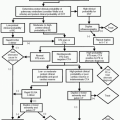Necrotizing Enterocolitis
Douglas E. Ramsey
Necrotizing enterocolitis (NEC) is one of the most common surgical emergencies in neonates. A high index of suspicion and early diagnosis are critical to improving the chance of survival. Although radiologic findings may be nonspecific, prompt communication with clinicians is crucial when necrotizing enterocolitis is considered in a differential diagnosis.
Pathogenesis and Epidemiology.
The precise mechanism underlying NEC is not well understood. A leading explanation postulates that intestinal ischemia allows bacterial overgrowth, which may ultimately cause bowel perforation. Conditions which may cause ischemia, such as perinatal hypoxia, congenital heart disease, and hypotension, intestinal allows bacterial overgrowth, which cause bowel perforation are all risk factors for NEC. Introduction of milk or formula then provides a medium for bacterial overgrowth and infiltration of the bowel. Several risk factors have been statistically associated with necrotizing enterocolitis, including advanced maternal age, premature rupture of membranes, preterm delivery, low birth weight (<2,000 g), and maternal cocaine exposure.
Most infants diagnosed with necrotizing enterocolitis are small for gestational age and/or preterm, however full-term neonates may also be affected if they develop intestinal ischemia. Prevalence of NEC is as high as 4% in children with birth weights less than 2,000 g, affecting both sexes equally. NEC accounts for approximately 2% of neonatal intensive care unit (NICU) admissions.
Signs and Symptoms.
Feeding intolerance and abdominal distension may be the first signs of NEC, especially in full-term infants. Most patients with NEC have guaiac-positive stool or frank hematochezia. Peritonitis, including abdominal tenderness, is a typically later sign that may suggest perforation. Signs of generalized sepsis, including worsening metabolic acidosis, apnea, lethargy, and hypotension are seen in fulminant cases. Patients may have fever, leukocytosis, or even manifest disseminated intravascular coagulation, with thrombocytopenia. Blood and stool cultures may reveal any of a variety of organisms, all of which could precipitate NEC.
Stay updated, free articles. Join our Telegram channel

Full access? Get Clinical Tree



